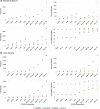Adduct annotation in liquid chromatography/high-resolution mass spectrometry to enhance compound identification
- PMID: 33123762
- PMCID: PMC7806579
- DOI: 10.1007/s00216-020-03019-3
Adduct annotation in liquid chromatography/high-resolution mass spectrometry to enhance compound identification
Erratum in
-
Correction to: Adduct annotation in liquid chromatography/high-resolution mass spectrometry to enhance compound identification.Anal Bioanal Chem. 2021 Feb;413(5):1505. doi: 10.1007/s00216-020-03148-9. Epub 2021 Jan 12. Anal Bioanal Chem. 2021. PMID: 33438044 Free PMC article. No abstract available.
Abstract
Annotation and interpretation of full scan electrospray mass spectra of metabolites is complicated by the presence of a wide variety of ions. Not only protonated, deprotonated, and neutral loss ions but also sodium, potassium, and ammonium adducts as well as oligomers are frequently observed. This diversity challenges automatic annotation and is often poorly addressed by current annotation tools. In many cases, annotation is integrated in metabolomics workflows and is based on specific chromatographic peak-picking tools. We introduce mzAdan, a nonchromatography-based multipurpose standalone application that was developed for the annotation and exploration of convolved high-resolution ESI-MS spectra. The tool annotates single or multiple accurate mass spectra using a customizable adduct annotation list and outputs a list of [M+H]+ candidates. MzAdan was first tested with a collection of 408 analytes acquired with flow injection analysis. This resulted in 402 correct [M+H]+ identifications and, with combinations of sodium, ammonium, and potassium adducts and water and ammonia losses within a tolerance of 10 mmu, explained close to 50% of the total ion current. False positives were monitored with mass accuracy and bias as well as chromatographic behavior which led to the identification of adducts with calcium instead of the expected potassium. MzAdan was then integrated in a workflow with XCMS for the untargeted LC-MS data analysis of a 52 metabolite standard mix and a human urine sample. The results were benchmarked against three other annotation tools, CAMERA, findMAIN, and CliqueMS: findMAIN and mzAdan consistently produced higher numbers of [M+H]+ candidates compared with CliqueMS and CAMERA, especially with co-eluting metabolites. Detection of low-intensity ions and correct grouping were found to be essential for annotation performance. Graphical abstract.
Keywords: Adducts; Electrospray; HRMS; Liquid chromatography; Metabolomics; Software.
Conflict of interest statement
The authors declare that they have no conflicts of interest.
Figures







Similar articles
-
Compound annotation in liquid chromatography/high-resolution mass spectrometry based metabolomics: robust adduct ion determination as a prerequisite to structure prediction in electrospray ionization mass spectra.Rapid Commun Mass Spectrom. 2017 Aug 15;31(15):1261-1266. doi: 10.1002/rcm.7905. Rapid Commun Mass Spectrom. 2017. PMID: 28499062
-
Metabolomic spectral libraries for data-independent SWATH liquid chromatography mass spectrometry acquisition.Anal Bioanal Chem. 2018 Mar;410(7):1873-1884. doi: 10.1007/s00216-018-0860-x. Epub 2018 Feb 6. Anal Bioanal Chem. 2018. PMID: 29411086
-
ALLocator: an interactive web platform for the analysis of metabolomic LC-ESI-MS datasets, enabling semi-automated, user-revised compound annotation and mass isotopomer ratio analysis.PLoS One. 2014 Nov 26;9(11):e113909. doi: 10.1371/journal.pone.0113909. eCollection 2014. PLoS One. 2014. PMID: 25426929 Free PMC article.
-
Challenges, progress and promises of metabolite annotation for LC-MS-based metabolomics.Curr Opin Biotechnol. 2019 Feb;55:44-50. doi: 10.1016/j.copbio.2018.07.010. Epub 2018 Aug 20. Curr Opin Biotechnol. 2019. PMID: 30138778 Review.
-
Mass spectrometric based approaches in urine metabolomics and biomarker discovery.Mass Spectrom Rev. 2017 Mar;36(2):115-134. doi: 10.1002/mas.21455. Epub 2015 Apr 16. Mass Spectrom Rev. 2017. PMID: 25881008 Review.
Cited by
-
Integrated microbiology and metabolomic analysis reveal the improvement of rice straw silage quality by inoculation of Lactobacillus brevis.Biotechnol Biofuels Bioprod. 2023 Nov 28;16(1):184. doi: 10.1186/s13068-023-02431-y. Biotechnol Biofuels Bioprod. 2023. PMID: 38017535 Free PMC article.
-
Systematic analysis of in-source modifications of primary metabolites during flow-injection time-of-flight mass spectrometry.Anal Biochem. 2023 Mar 1;664:115036. doi: 10.1016/j.ab.2023.115036. Epub 2023 Jan 7. Anal Biochem. 2023. PMID: 36627043 Free PMC article.
-
Decoding the Foodome: Molecular Networks Connecting Diet and Health.Annu Rev Nutr. 2024 Aug;44(1):257-288. doi: 10.1146/annurev-nutr-062322-030557. Annu Rev Nutr. 2024. PMID: 39207880 Free PMC article. Review.
-
Chemical Elicitors Induce Rare Bioactive Secondary Metabolites in Deep-Sea Bacteria under Laboratory Conditions.Metabolites. 2021 Feb 12;11(2):107. doi: 10.3390/metabo11020107. Metabolites. 2021. PMID: 33673148 Free PMC article.
-
Spontaneous Water Radical Cation Oxidation at Double Bonds in Microdroplets.Front Chem. 2022 Apr 26;10:903774. doi: 10.3389/fchem.2022.903774. eCollection 2022. Front Chem. 2022. PMID: 35559217 Free PMC article.
References
MeSH terms
Substances
LinkOut - more resources
Full Text Sources

